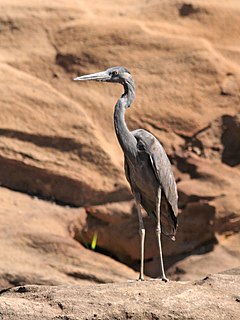 W
WArdea is a genus of herons. The genus name comes from Latin ardea "heron". These herons are generally large in size, typically 80–100 cm or more in length.
 W
WThe Bennu heron is an extinct, very large heron from the area that now is the United Arab Emirates. Remains of the heron have been dated to 2700–1800 BCE, coinciding with the Umm al-Nar period.
 W
WThe cocoi heron is a species of long-legged wading bird in the heron family Ardeidae found across South America. It has predominantly pale grey plumage with a darker grey crest. A carnivore, it hunts fish and crustaceans in shallow water.
 W
WThe eastern great egret, a white heron in the genus Ardea, is usually considered a subspecies of the great egret. In New Zealand it is known as the white heron or by its Māori name kōtuku. The subspecies was first described by British ornithologist John Edward Gray in 1831.
 W
WThe Goliath heron, also known as the giant heron, is a very large wading bird of the heron family, Ardeidae. It is found in sub-Saharan Africa, with smaller numbers in Southwest and South Asia.
 W
WThe great blue heron is a large wading bird in the heron family Ardeidae, common near the shores of open water and in wetlands over most of North America and Central America, as well as the Caribbean and the Galápagos Islands. It is a rare vagrant to coastal Spain, the Azores, and areas of far southern Europe. An all-white population found in south Florida and the Florida Keys is known as the great white heron. Debate exists about whether this represents a white color morph of the great blue heron, a subspecies of it, or an entirely separate species. The status of white individuals known to occur elsewhere in the Caribbean, and very rarely elsewhere in eastern North America, is unclear.
 W
WThe great egret (Ardea alba), also known as the common egret, large egret, or great white egret or great white heron is a large, widely distributed egret, with four subspecies found in Asia, Africa, the Americas, and southern Europe. Distributed across most of the tropical and warmer temperate regions of the world, it builds tree nests in colonies close to water.
 W
WThe great-billed heron is a wading bird of the heron family, resident from southeast Asia to Papua New Guinea and Australia.
 W
WThe grey heron is a long-legged predatory wading bird of the heron family, Ardeidae, native throughout temperate Europe and Asia and also parts of Africa. It is resident in much of its range, but some populations from the more northern parts migrate southwards in autumn. A bird of wetland areas, it can be seen around lakes, rivers, ponds, marshes and on the sea coast. It feeds mostly on aquatic creatures which it catches after standing stationary beside or in the water or stalking its prey through the shallows.
 W
WThe black-headed heron is a wading bird of the heron family Ardeidae, common throughout much of sub-Saharan Africa and Madagascar. It is mainly resident, but some west African birds move further north in the rainy season.
 W
WHumblot's heron, also known as the Madagascar heron, is a species of heron. In Madagascar, it is common on the north and west coasts of the island, but is also found inland, especially near Lake Alaotra. It is also present in the Comoro Islands and Mayotte. Humblot's heron is an endangered species, with a population estimated at only 1,500 mature individuals. Its population is apparently declining. The major threats the heron faces are poaching and habitat destruction
 W
WThe intermediate egret, median egret, smaller egret, or yellow-billed egret is a medium-sized heron. Some taxonomists put the species in the genus Egretta or Mesophoyx. It is a resident breeder from east Africa across the Indian subcontinent to Southeast Asia and Australia.
 W
WThe purple heron is a wide-ranging species of wading bird in the heron family, Ardeidae. The scientific name comes from Latin ardea "heron", and purpureus, "coloured purple". It breeds in Africa, central and southern Europe, and southern and eastern Asia. The Western Palearctic populations migrate between breeding and wintering habitats whereas the African and tropical-Asian populations are primarily sedentary, except for occasional dispersive movements.
 W
WThe white-bellied heron, also known as the imperial heron or great white-bellied heron, is a species of large heron known from the foothills of the eastern Himalayas in India and Bhutan to northeastern Bangladesh and Myanmar. It is mostly solitary and occurs in undisturbed riverside or wetlands. It has been listed as Critically Endangered on the IUCN Red List since 2007, because the global population is estimated at less than 300 mature individuals and threatened by habitat loss and human disturbance.
 W
WThe white-necked heron or Pacific heron is a species of heron that is found on most of the Australian continent wherever freshwater habitats exist. It is also found in parts of Indonesia, New Guinea and New Zealand, but is uncommon in Tasmania. The populations of this species in Australia are known to be nomadic like most water birds in Australia, moving from one water source to another often entering habitats they have not previously occupied, taking advantage of flooding and heavy rain where the surplus of food allows them to breed and raise their young. Population explosions have been known when the environmental conditions are right for this species in places where they have been rare or unknown.